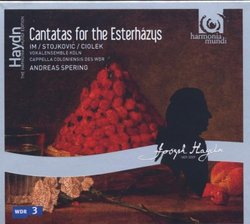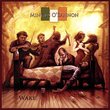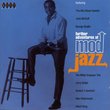| All Artists: Franz Joseph Haydn, Andreas Spering, Nicholas Kraemer, Capella Coloniensis Orchestra, Christine Wehler, Konstanze Maxsein, Bernard Scheffel, Sunhae Im Title: Haydn: Cantatas for the Esterházys Members Wishing: 0 Total Copies: 0 Label: Harmonia Mundi Fr. Original Release Date: 1/1/2008 Re-Release Date: 11/11/2008 Album Type: Import Genre: Classical Styles: Opera & Classical Vocal, Historical Periods, Classical (c.1770-1830), Symphonies Number of Discs: 1 SwapaCD Credits: 1 UPC: 794881892228 |
Search - Franz Joseph Haydn, Andreas Spering, Nicholas Kraemer :: Haydn: Cantatas for the Esterházys
 | Franz Joseph Haydn, Andreas Spering, Nicholas Kraemer Haydn: Cantatas for the Esterházys Genre: Classical |
Larger Image |
CD DetailsSimilar CDs
|
CD ReviewsThe Curious Case of Haydn v. Telemann Giordano Bruno | Wherever I am, I am. | 09/23/2009 (5 out of 5 stars) "Why do all true baseball fans love Baroque music? (We can agree to presume so for the purposes of this review, can't we?) Because baseball is the original "historically informed" sport! And are you aware, dear reader, of the indelible association of baseball with the development of statistics as a methodology both of business and historiography in the USA? I'm not kidding. If you're interested, take a look at "Baseball as History" by Dr. Jules Tygiel, the most enlightening study ever written about a sport in its social context. Now let's suppose that a baseball-trained pollster had kept records of musical accomplishments in the 18th Century and tried to determine the two composers with the highest ratings of fan appreciation. The two greatest composers of the century, in other words, in the 'ears' of their contemporaries decade after decade. I have little doubt that they would be Georg Philipp Telemann (1681-1767) and Joseph Haydn (1732-1809). Telemann and Haydn overlapped for 25 years, from Haydn's birth in '32 to Telemann's death in '67, and Telemann wrote much of his finest vocal music in his 'golden' years in Hamburg precisely while Haydn was writing his earliest works as Kapellmeister in Esterhaza, including the pieces on this CD. It's an odd moment of juxtaposition, the venerable Telemann boldly advancing through Rococo toward Classicism and the youthful Haydn still lingering in the Baroque of A. Scarlatti and, yes, earlier Telemann. The three short cantatas recorded here are minor compositions in the oeuvre of Haydn and scarcely bear comparison to the masterworks of Telemann of the same decade, but they're lovely music nonetheless. All three were written 'on assignment' for the name-day celebrations of Prince Nicholas Esterházy, Haydn's employee and all-but-owner. (Haydn's contracted servitude to Esterházy is another reminder of the similarity of working conditions of Baroque composers and baseball players.) The texts of all three are replete with fawning sycophancy and fulsome bombast; if ever one might ignore the words and just listen to the music, this would be the time. Just listen to the sprightly duets of Destatevi O Miei Fidi and the sparkly soprano aria of Qual Dubbio Ormai, and imagine that the singers are the usual charming shepherdesses of a pastoral cantata by Scarlatti or Handel. Likewise the contrapuntal choruses that conclude each of the three paeans of flattery for "the boss"! Good music! Way more than the occasion called for in retrospect, but sopranos Sunhae Im and Johanna Stojkovic more than rise to the occasion. Haydn's recitativos are not especially creative or thrilling, but what can one expect from a text like this: ""With what unexpected joy is my soul surprised, and what happy voices sound around me? Does my glance deceive me, or do I see the populace run in motley groups to the princely palace? What day is this? Ah yes, I understand, the eminent Prince, our gracious Sovereign, he for whom each subject so longs, heaven has restored him... Oh happy we!"" Phaugh! 'Unexpected' perhaps, but it'd better be well rehearsed, Joe, or you'll be hunting for a job as second fiddle in Slobovia! Conductor Andreas Spering and the Capella Coloniensis orchestra, playing scrupulously authentic historical instruments, replicate the polished elegance that must have been demanded of Haydn's corps of musicians by the magnificent Esterházy autocrat. You might pay attention to Haydn's artful writing for bassoon; the bassoon of Telemann's and Haydn's orchestra was still an instrument of 'vocal' timbre and flexibility. This CD is rounded out with Haydn's Symphony #12 in E major, a key especially suitable for blending the colors of period horns and strings. If the three cantatas look backward toward Baroque models, this little symphony points boldly forward toward Haydn's future as the "intelligent designer" of the classical and romantic symphonies of everyone since." HE WAS YOUNG ONCE DAVID BRYSON | Glossop Derbyshire England | 03/30/2009 (5 out of 5 stars) "Concertgoers and record collectors of my generation behaved in practice as if Haydn wrote only late works. Nobody had heard of any symphonies with sequence numbers lower than 85, of quartets with opus-numbers below 70 or of vocal works other than The Creation, The Seasons and a few masses. Old habits die hard, and to this day my collection of Haydn's symphonies and piano sonatas is heavily weighted towards the back end, the situation is only a little better with the quartets, and if I did not own complete sets of the piano trios and baryton trios, and if I had not played one or two early piano sonatas as a boy, I would have been in danger of ending my days virtually ignorant of Haydn's early work.
How the matter is with the next two generations I don't know, but in recent decades the opportunities have not been lacking to achieve a better balance in the matter. I actually own another of his cantatas, also from the Esterhazy period, but that is courtesy of Dame Janet Baker via the BBC in a miscellaneous programme. What this disc offers is a coherent theme, namely the master's work dating from his early 30's at the Esterhazy court. There are three short cantatas here, plus the symphony numbered 12. If Haydn could write a symphony numbered 87 he must have written one numbered 12: it stands to reason. It is all most educative, it is very well done indeed both as regards the performances and as regards the production, and it would be a crying shame if the opportunity offered to us is neglected. The style adopted is fully `authentic'. The instruments are all `period' instruments from the sound of them, and the keyboard part is taken on a harpsichord. Not all the singing is quite what I might have expected in a production by, say, McCreesh as far as style goes, but this is Haydn, not Handel. I had heard Sunhae Im and Johanna Stoikovic before, that was in Handel, and I remember thinking that Im was more of a modern stylist than her colleagues. That did not bother me there, and it does not bother me here. She is a superb singer, so is Stoikovic, and the choirmaster Max Ciolek, who takes the tenor part in the duet that calls for that, does not let them down. The music of the cantatas has yet to bowl me over, but these are early days, and I am still pursuing my musical education with the help of productions like this. Whatever they amount to, this is surely how these works ought to sound. Symphony no.12 is directed by a different conductor from the cantatas. It is in three movements only, with no minuet, and even at this preliminary stage I found the finale at least to be very attractive and engaging. I suppose really that Haydn was not early in developing his full potential, and the unadventurous view of his work that was the norm when I was younger is at least explicable to that extent. To any music lovers still experiencing reluctance to take advantage of what this issue offers us, my earnest message is `Get over it.' One does not have to be any wholesale convert to the `authentic' movement to have learned to hear different styles of performance and different styles of music with different ears from the ears we developed in earlier times for later music. That is the debt that any and all of us owe to the authentic school, if we are serious about serious music, and I for one am thoroughly grateful. The record is attractively packaged, and there are learned and informative essays on the music, on the princes Esterhazy, and on the Haydns, Michael was well as Joseph. The recording is from 2002, so one would not expect to find faults with it in any technical respects. There is a sense of `quality' about it all. I would guess confidently that it will be a success with specialists in this kind of music, but I also hope that its appeal reaches further that that." |



